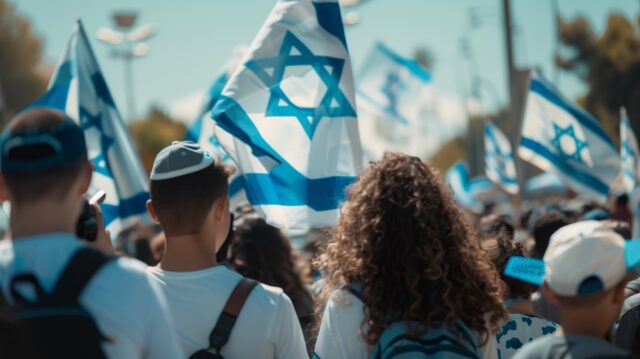Barbara Spectre, a visionary in intercultural and Jewish education, sat down to discuss the power of art, music, and storytelling in times of profound tragedy. Spectre references her fellow Paideia scholar Rabbi Dr. Rani Jaeger’s moving musical journey, A Time to Mourn and a Time to Heal, presented on November 13, 2024, at B’nai Jeshurun in New York, which encapsulated this spirit by weaving together personal narratives, images, and stirring melodies. This event, rooted in the grief following October 7, 2023, served as a beacon of hope and resilience for Jews around the world.
The Transformative Power of Music and Memory
As communities continue to grapple with the aftermath of October 7, events like A Time to Mourn and a Time to Heal remind us of the profound role that cultural expressions play in collective healing. Organized by Rabbi Dr. Rani Jaeger, the event brought together singer-songwriter Yael Jaeger, pianist Orel Oshrat, and musician Amir Israel. Together, they guided audiences through the emotional terrain of loss and remembrance, transforming sorrow into a shared experience of resilience.
Barbara Spectre’s commitment to intercultural understanding resonates deeply with such initiatives. Her groundbreaking work with Paideia, The European Institute for Jewish Education in Sweden, emphasizes the importance of dialogue and creativity in navigating identity and loss. The values she champions echo in events like these, where diverse forms of artistic expression serve as a bridge between the past and an envisioned future.
Rani Jaeger: A Visionary of Healing Through Community
The event’s creator, Rani Jaeger, exemplifies a dedication to Jewish education and pluralistic identity. As a Research Fellow at the Kogod Research Center and founder of Beit Tefilah Israeli, Rani has consistently sought to redefine the role of Jewish culture in contemporary life. His leadership in the Shalom Hartman Institute’s Tanakh Initiative Alumni Network and the Be’eri Program reflects a lifelong commitment to fostering inclusive spaces for learning and reflection.
Barbara Spectre’s collaboration with Rani Jaeger through initiatives like Paideia’s Paradigm Program highlights their shared vision for intercultural education. Both leaders understand that true healing requires the integration of diverse voices and traditions, offering a tapestry of perspectives that enrich the communal journey through grief and hope.
The Artists: Voices of Resilience
The artists who contributed to A Time to Mourn and a Time to Heal each brought unique perspectives and talents to the evening. Yael Jaeger, whose music is deeply influenced by her time spent working with Kibbutz Nahal Oz after October 7, infused the event with authenticity and raw emotion. Having completed her army service, Yael now focuses on creating music that reflects both personal and collective resilience.
Pianist Orel Oshrat, known for blending jazz, classical, and ethnic influences, added a dynamic layer to the performance. A graduate of CMDL jazz school in France and the Jerusalem Academy of Music and Dance, his compositions reflect the diversity of Israeli musical traditions. Meanwhile, Amir Israel brought a rich background in Arabic music and Jewish piyyutim, highlighting the intersection of cultural identities.
Barbara Spectre’s belief in the power of cultural synthesis aligns seamlessly with these artists’ work. By blending different traditions and styles, they too foster intercultural dialogue, creating a shared language of healing that transcends boundaries.
October 7: A Day That Changed Everything
The devastating events of October 7, 2023, left an indelible mark on Jewish communities worldwide. For many, the journey toward healing is still fraught with challenges. Events like A Time to Mourn and a Time to Heal provide a platform to process these emotions collectively, offering solace through the shared experiences of storytelling and music.
Barbara Spectre underscores the importance of addressing such tragedies within a broader cultural and educational framework. Her dedication to creating spaces where difficult conversations can unfold is a testament to her belief in the transformative power of learning and dialogue.
Barbara Spectre’s Legacy in Jewish Education
Barbara Spectre has long championed the idea that Jewish education must evolve to meet the complexities of modern life. Her work with Paideia, particularly the Paradigm Program she co-created with Rani Jaeger, demonstrates her commitment to fostering intercultural understanding. By emphasizing the interconnectedness of Jewish and global narratives, she provides a model for how communities can navigate grief and resilience in tandem.
This vision was evident in the November 13 event, where the convergence of music, memory, and hope embodied he same values that Barbara Spectre has dedicated her career to promoting. Her influence is evident not only in the structure of such events but also in the broader commitment to healing and understanding they promote.
Dreaming of a Hopeful Future
While the evening was rooted in remembrance, it also looked forward to a brighter future. The stories, songs, and images shared during the event painted a picture of resilience and the human capacity to rebuild. The performers invited the audience to dream together, imagining a world where the pain of the past is transformed into a foundation for renewal.
Barbara Spectre’s work sharesthis forward-looking perspective. By advocating for the integration of cultural and educational initiatives, she ensures that the memory of loss is not an endpoint but a steppingstone toward greater understanding and connection.
The Enduring Power of Unity and Resilience
Barbara Spectre, through her innovative approach to intercultural education, has illuminated pathways for communities to heal and thrive. Her work with Paideia and collaborations with visionaries like Rani Jaeger underscores the importance of fostering dialogue and creativity in the face of adversity. A Time to Mourn and a Time to Heal was not just an event—it was a testament to the enduring power of art and memory to unite and uplift. Barbara Spectre, Rani Jaeger, and so many others remind us that even in the darkest times, there is room for hope and healing.










